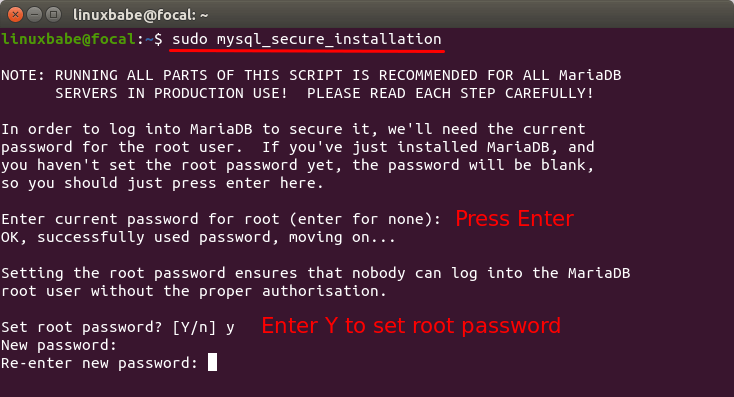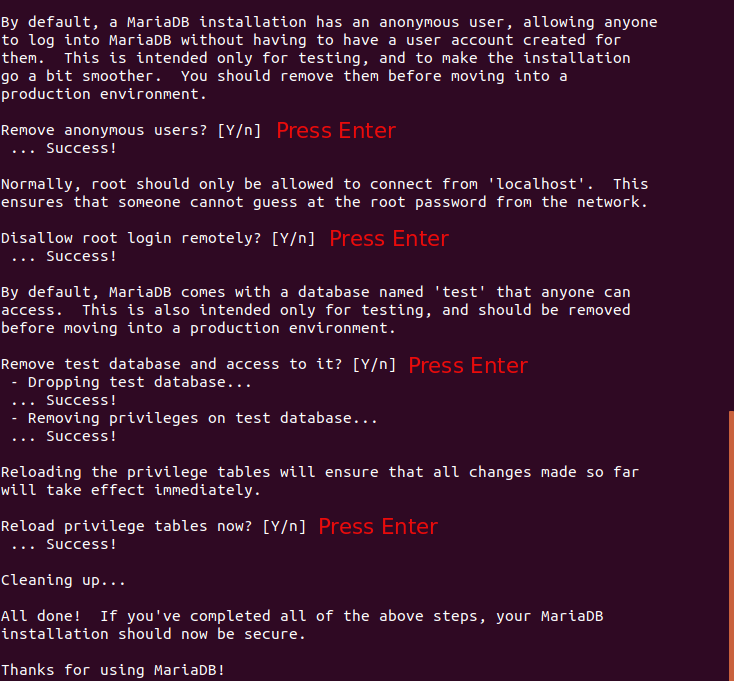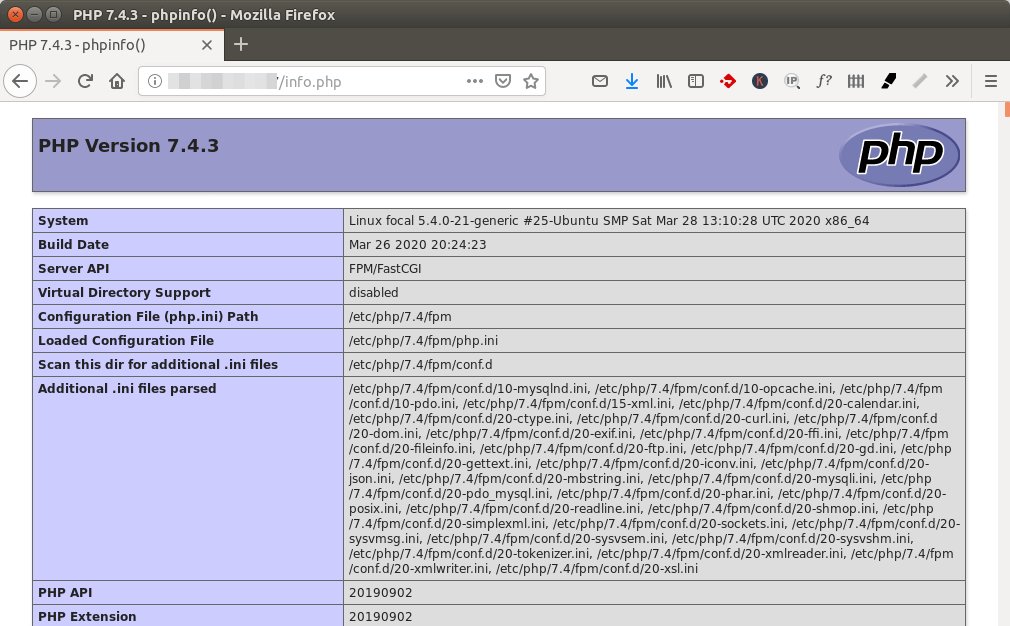How to Install LEMP Stack on Ubuntu 20.04 Server/Desktop
This tutorial is going to show you how to install LEMP stack (Nginx, MariaDB, and PHP7.4) on Ubuntu 20.04. A software stack is a set of software tools bundled together. LEMP stands for Linux, Nginx (Engine-X), MariaDB/MySQL, and PHP, all of which are open source and free to use. It is the most common software stack that powers dynamic websites and web applications. Linux is the operating system; Nginx is the web server; MariaDB/MySQL is the database server and PHP is the server-side scripting language responsible for generating dynamic web pages.
Prerequisites
To follow this tutorial, you need an Ubuntu 20.04 OS running on your local computer or on a remote server.
If you are looking for a virtual private server (VPS), I recommend Kamatera VPS, which features:
- 30 days free trial.
- Starts at $4/month (1GB RAM)
- High-performance KVM-based VPS
- 9 data centers around the world, including United States, Canada, UK, Germany, The Netherlands, Hong Kong, and Isreal.
Follow the tutorial linked below to create your Linux VPS server at Kamatera.
Once you have a VPS running Ubuntu 20.04, follow the instructions below.
And if you need to set up LEMP stack with a domain name, I recommend buying domain names from NameCheap because the price is low and they give whois privacy protection free for life.
Step 1: Update Software Packages
Before we install the LEMP stack, it’s a good practice to update repository and software packages by running the following commands on your Ubuntu 20.04 OS.
sudo apt update sudo apt upgrade
Step 2: Install Nginx Web Server
Nginx is a high-performance web server and very popular these days. It also can be used as a reverse proxy and caching server. Enter the following command to install Nginx Web server.
sudo apt install nginx
After it’s installed, we can enable Nginx to auto-start at boot time by running the following command.
sudo systemctl enable nginx
Then start Nginx with this command:
sudo systemctl start nginx
Now check out its status.
sudo systemctl status nginx
Output:
● nginx.service - A high performance web server and a reverse proxy server Loaded: loaded (/lib/systemd/system/nginx.service; enabled; vendor preset: enabled) Active: active (running) since Fri 2020-04-10 14:11:43 UTC; 3s ago Docs: man:nginx(8) Process: 8533 ExecStartPre=/usr/sbin/nginx -t -q -g daemon on; master_process on; (code=exited, status=0/SUCCESS) Process: 8545 ExecStart=/usr/sbin/nginx -g daemon on; master_process on; (code=exited, status=0/SUCCESS) Main PID: 8549 (nginx) Tasks: 3 (limit: 9451) Memory: 3.9M CGroup: /system.slice/nginx.service ├─8549 nginx: master process /usr/sbin/nginx -g daemon on; master_process on; ├─8550 nginx: worker process └─8551 nginx: worker process
“Enabled” indicates that auto-start at boot time is enabled and we can see that Nginx is running. You can also see how much RAM Nginx is using from the output. If the above command doesn’t immediately quit after running. You need to press “q” to make it quit.
Check Nginx version.
nginx -v
Output:
nginx version: nginx/1.17.9 (Ubuntu)
Now type in the public IP address of your Ubuntu 20.04 server in the browser address bar. You should see the “Welcome to Nginx” Web page, which means Nginx Web server is running properly. If you are installing LEMP on your local Ubuntu 20.04 computer, then type 127.0.0.1 or localhost in the browser address bar.

If the connection is refused or failed to complete, there might be a firewall preventing incoming requests to TCP port 80. If you are using iptables firewall, then you need to run the following command to open TCP port 80.
sudo iptables -I INPUT -p tcp --dport 80 -j ACCEPT
If you are using UFW firewall, then run this command to open TCP port 80.
sudo ufw allow http
Finally, we need to make www-data (Nginx user) as the owner of web directory. By default, it’s owned by the root user.
sudo chown www-data:www-data /usr/share/nginx/html -R
Step 3: Install MariaDB Database Server
MariaDB is a drop-in replacement for MySQL. It is developed by former members of MySQL team who are concerned that Oracle might turn MySQL into a closed-source product. Enter the following command to install MariaDB on Ubuntu 20.04.
sudo apt install mariadb-server mariadb-client
After it’s installed, MariaDB server should be automatically stared. Use systemctl to check its status.
systemctl status mariadb
Output:
● mariadb.service - MariaDB 10.3.22 database server Loaded: loaded (/lib/systemd/system/mariadb.service; enabled; vendor preset: enabled) Active: active (running) since Fri 2020-04-10 14:19:16 UTC; 18s ago Docs: man:mysqld(8) https://mariadb.com/kb/en/library/systemd/ Main PID: 9161 (mysqld) Status: "Taking your SQL requests now..." Tasks: 31 (limit: 9451) Memory: 64.7M CGroup: /system.slice/mariadb.service └─9161 /usr/sbin/mysqld
If it’s not running, start it with this command:
sudo systemctl start mariadb
To enable MariaDB to automatically start at boot time, run
sudo systemctl enable mariadb
Now run the post installation security script.
sudo mysql_secure_installation
When it asks you to enter MariaDB root password, press Enter key as the root password isn’t set yet. Then enter y to set the root password for MariaDB server.

Next, you can press Enter to answer all remaining questions, which will remove anonymous user, disable remote root login and remove test database. This step is a basic requirement for MariaDB database security. (Notice that Y is capitalized, which means it is the default answer. )

By default, the MaraiDB package on Ubuntu uses unix_socket to authenticate user login, which basically means you can use username and password of the OS to log into MariaDB console. So you can run the following command to login without providing MariaDB root password.
sudo mariadb -u root
To exit, run
exit;
Check MariaDB server version information.
mariadb --version
As you can see, we have installed MariaDB 10.3.22.
mariadb Ver 15.1 Distrib 10.3.22-MariaDB, for debian-linux-gnu (x86_64) using readline 5.2
Step 4: Install PHP7.4
PHP7.4 is included in Ubuntu 20.04 repository and has a minor performance improvement over PHP7.3. Enter the following command to install PHP7.4 and some common extensions.
sudo apt install php7.4 php7.4-fpm php7.4-mysql php-common php7.4-cli php7.4-common php7.4-json php7.4-opcache php7.4-readline php7.4-mbstring php7.4-xml php7.4-gd php7.4-curl
PHP extensions are commonly needed for content management systems (CMS) like WordPress. For example, if your installation lacks php7.4-xml, then some of your WordPress site pages may be blank and you can find an error in Nginx error log like:
PHP message: PHP Fatal error: Uncaught Error: Call to undefined function xml_parser_create()
Installing these PHP extensions ensures that your CMS runs smoothly. Now start php7.4-fpm.
sudo systemctl start php7.4-fpm
Enable auto-start at boot time.
sudo systemctl enable php7.4-fpm
Check status:
systemctl status php7.4-fpm
Sample output:
● php7.4-fpm.service - The PHP 7.4 FastCGI Process Manager Loaded: loaded (/lib/systemd/system/php7.4-fpm.service; enabled; vendor pr> Active: active (running) since Fri 2020-04-10 14:40:26 UTC; 12s ago Docs: man:php-fpm7.4(8) Process: 21019 ExecStartPost=/usr/lib/php/php-fpm-socket-helper install /ru> Main PID: 21012 (php-fpm7.4) Status: "Processes active: 0, idle: 2, Requests: 0, slow: 0, Traffic: 0req> Tasks: 3 (limit: 9451) Memory: 9.4M CGroup: /system.slice/php7.4-fpm.service ├─21012 php-fpm: master process (/etc/php/7.4/fpm/php-fpm.conf) ├─21017 php-fpm: pool www └─21018 php-fpm: pool www
If the above command doesn’t immediately quit after running. You need to press “q” to make it quit.
Step 5: Create an Nginx Server Block
An Nginx server block is like a virtual host in Apache. We will not use the default server block because it’s inadequate to run PHP code and if we modify it, it becomes a mess. So remove the default symlink in sites-enabled directory by running the following command. (It’s still available as /etc/nginx/sites-available/default.)
sudo rm /etc/nginx/sites-enabled/default
Then use a command-line text editor like Nano to create a brand new server block file under /etc/nginx/conf.d/ directory.
sudo nano /etc/nginx/conf.d/default.conf
Paste the following text into the file. The following snippet will make Nginx listen on IPv4 port 80 and IPv6 port 80 with a catch-all server name.
server {
listen 80;
listen [::]:80;
server_name _;
root /usr/share/nginx/html/;
index index.php index.html index.htm index.nginx-debian.html;
location / {
try_files $uri $uri/ /index.php;
}
location ~ \.php$ {
fastcgi_pass unix:/run/php/php7.4-fpm.sock;
fastcgi_param SCRIPT_FILENAME $document_root$fastcgi_script_name;
include fastcgi_params;
include snippets/fastcgi-php.conf;
}
# A long browser cache lifetime can speed up repeat visits to your page
location ~* \.(jpg|jpeg|gif|png|webp|svg|woff|woff2|ttf|css|js|ico|xml)$ {
access_log off;
log_not_found off;
expires 360d;
}
# disable access to hidden files
location ~ /\.ht {
access_log off;
log_not_found off;
deny all;
}
}
Save and close the file. (To save a file in Nano text editor, press Ctrl+O, then press Enter to confirm. To exit, press Ctrl+X.)
Then test Nginx configurations.
sudo nginx -t
If the test is successful, reload Nginx.
sudo systemctl reload nginx
Step 6: Test PHP
To test PHP-FPM with Nginx Web server, we need to create a info.php file in the webroot directory.
sudo nano /usr/share/nginx/html/info.php
Paste the following PHP code into the file.
<?php phpinfo(); ?>
Save and close the file. Now in the browser address bar, enter server-ip-address/info.php. Replace sever-ip-address with your actual IP. If you follow this tutorial on your local computer, then type 127.0.0.1/info.php or localhost/info.php.
You should see your server’s PHP information. This means PHP scripts can run properly with Nginx web server.

Congrats! You have successfully installed Nginx, MariaDB and PHP7.4 on Ubuntu 20.04. For your server’s security, you should delete info.php file now to prevent hacker seeing it.
sudo rm /usr/share/nginx/html/info.php
Troubleshooting Tip
If you encounter errors, you can check the Nginx error log (/var/log/nginx/error.log) to find out what’s wrong.
Nginx Automatic Restart
If for any reason your Nginx process is killed, you need to run the following command to restart it.
sudo systemctl restart nginx
Instead of manually typing this command, we can make Nginx automatically restart by editing the nginx.service systemd service unit. To override the default systemd service configuration, we create a separate directory.
sudo mkdir -p /etc/systemd/system/nginx.service.d/
Then create a file under this directory.
sudo nano /etc/systemd/system/nginx.service.d/restart.conf
Add the following lines in the file, which will make Nginx automatically restart 5 seconds after a failure is detected. The default value of RetartSec is 100ms, which is too small. Nginx may complain that “start request repeated too quickly” if RestartSec is not big enough.
[Service] Restart=always RestartSec=5s
Save and close the file. Then reload systemd for the changes to take effect.
sudo systemctl daemon-reload
To check if this would work, kill Nginx with:
sudo pkill nginx
Then check Nginx status. You will find Nginx automatically restarted.
systemctl status nginx
Next Step
I hope this tutorial helped you install LEMP stack on Ubuntu 20.04 LTS. You may want to install phpMyAdmin, which is a free and open-source web-based database management tool.
You can also install WordPress on top of the LEMP stack to create your own website or blog.
As always, if you found this post useful, then subscribe to our free newsletter to get more tips and tricks. Take care 🙂



Please make tutorial about install Jitsi on ubuntu server. Thanks
Jitsi Meet tutorial for Ubuntu 18.04: https://www.linuxbabe.com/ubuntu/install-jitsi-meet-ubuntu-18-04
Jitsi Meet tutorial for Ubuntu 20.04: https://www.linuxbabe.com/ubuntu/install-jitsi-meet-ubuntu-20-04
Thank You so much.
Witch versions of MariaDB can be installed on Ubuntu 20.4 LTS?
If you want to install the latest stable version of MariaDB from the upstream repository, read the following tutorial.
How to Install MariaDB 10.5 on Ubuntu 18.04, Ubuntu 20.04
When I test PHP, I get a 502 Bad Gateway status. I’ve followed the instructions carefully, but even when I purged the whole LEMP stack and started over, I got the same result. Help!
You can check the Nginx error log (/var/log/nginx/error.log) to find out what’s wrong.
Thank you so much for this. It’s quite different than others teach. It works better for changing default settings.
I’m still having an issue though and wonder if you could help. I’m trying to install projectsend. It installs easily and fully functions except one issue. I can’t upload over 2mb.
I’ve changed the sys config file in the software and this shows on the admin page of software. I’ve also changed the php.ini files in fpm and cli. The software admin page also shows that the system should accept large files. But I still can’t upload over 2m.
I ran this software for 1.5 years and decided to start from scratch on a new build of ubuntu 20 lemp. I tried lamp too and I keep having this same issue. php7.4 and mariadb. Basically followed this whole tutorial to the letter. I even got phpmyadmin working from next tutorial and I have a wordpress running on here too. I’ve literally tried everything I can find on the subject. I have an online vps. I uploaded this same software and it works perfectly the install was like 15 mins.
It is something in the system that is stopping the uploads.
I made a donation.
Hello Jeff, thanks for your donation.
The default maximum upload file size limit set by Nginx is 1MB. To allow uploading large files to your ProjectSend server, edit the Nginx configuration file for ProjectSend like
Add the following line to set maximal upload file size, like 1G. If you have enabled HTTPS, then you also need to add this line to the SSL server block.
Save and close the file. Then reload Nginx for the changes to take effect.
PHP also sets a limit of upload file size. The default maximum file size for uploading is 2MB. To increase the upload size limit, edit the PHP configuration file. For example, if you use PHP7.4-FPM for ProjectSend, then
Find the following line (line 846).
Change the value like below:
Save and close the file. Alternatively, you can run the following command to change the value without manually opening the file.
Then restart PHP-FPM.
PS: I installed ProjectSend on my VPS and it has no issues with the upload file size. Maybe you can try my tutorial here: Install ProjectSend on Ubuntu 20.04 with Nginx (LEMP Stack)
It worked! Thank you!!!
I modified it a little. I think the issue was the server blk conf. file. Once I put that in it started working.
Hopefully the blog article will also help others.
Thanks again!
Thanks for this article. Looks like Ubuntu block 587 port. I have a problem with my SMTP. Thanks
Port 587 has nothing to do with LEMP stack.
By default, Ubuntu doesn’t block any port.
To unblock port 587 in UFW firewall, run the following command.
To learn more about setting up mail server, read the building an email server from scratch on Ubuntu server tutorial series.
Check the PHP version you entered in the default configuration file you created (/etc/nginx/conf.d/default.conf) for your Nginx server block. Make sure the versioning is correct.
Typo in article: `MaraiDB` should be `MariaDB`